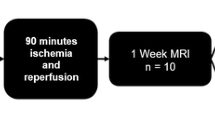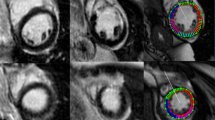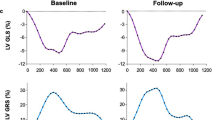Abstract
Purpose In the absence of additional ischemic insults, the peri-infarct region surrounding the infarct myocardium can recover function. T2 weighted MRI signal is sensitive to edema and used to detect peri-infarct, salvageable myocardium. The main purpose of this study was to investigate the alterations in myocardial strain in the peri-infarct myocardium as compared to normal and infarct myocardium. Materials and methods Comprehensive MRI of the myocardium was performed in five pigs 6–7 days following coronary artery occlusion–reperfusion myocardial injury. MRI included tagged cine images for myocardial strain, T2weighted (T2w)-images and late gadolinium enhancement (LGE) for assessing myocardial viability. Automated signal intensity thresholds were used to define tissue edema and myocardial infarct. Maximum-shortening strains were analyzed in the infarct, peri-infarct and normal myocardial sectors. The results were correlated with triphenyltetrazolium-chloride (TTC) and hemotoxylin–eosin stained tissue images. Results We found an excellent correlation of LGE with TTC (r = 0.94, P < 0.05). T2w-images markedly overestimated the infarct size (25 ± 3%). Both the healthy and peri-infarct myocardial sectors had higher myocardial strain than infarct myocardial sectors (P < 0.05). Clear demarcation between infarct and non-infarct myocardium was noted on histology. Conclusion Peri-infarct myocardium continues to demonstrate T2 signal enhancement to at least 7 days, but this region has preserved mechanical function. T2-weighted imaging and myocardial strain measurements provide complementary information and both may be useful for characterization of the peri-infarct myocardium.







Similar content being viewed by others

References
Richard V, Murry CE, Reimer KA (1995) Healing of myocardial infarcts in dogs. Effects of late reperfusion. Circulation 92(7):1891–1901
Fieno DS et al (2004) Infarct resorption, compensatory hypertrophy, and differing patterns of ventricular remodeling following myocardial infarctions of varying size. J Am Coll Cardiol 43(11):2124–2131. doi:10.1016/j.jacc.2004.01.043
Aletras AH et al (2006) Retrospective determination of the area at risk for reperfused acute myocardial infarction with T2-weighted cardiac magnetic resonance imaging: histopathological and displacement encoding with stimulated echoes (DENSE) functional validations. Circulation 113(15):1865–1870. doi:10.1161/CIRCULATIONAHA.105.576025
Stork A et al (2006) Characterization of the peri-infarction zone using T2-weighted MRI and delayed-enhancement MRI in patients with acute myocardial infarction. Eur Radiol 16(10):2350–2357. doi:10.1007/s00330-006-0232-3
Garcia-Dorado D et al (1993) Analysis of myocardial oedema by magnetic resonance imaging early after coronary artery occlusion with or without reperfusion. Cardiovasc Res 27(8):1462–1469. doi:10.1093/cvr/27.8.1462
Karolle BL et al (1991) Transmural distribution of myocardial edema by NMR relaxometry following myocardial ischemia and reperfusion. Am Heart J 122(3 Pt 1):655–664. doi:10.1016/0002-8703(91)90508-F
Boxt LM et al (1993) Estimation of myocardial water content using transverse relaxation time from dual spin-echo magnetic resonance imaging. Magn Reson Imaging 11(3):375–383. doi:10.1016/0730-725X(93)90070-T
Gerber BL et al (2000) Microvascular obstruction and left ventricular remodeling early after acute myocardial infarction. Circulation 101(23):2734–2741
Osman NF, McVeigh ER, Prince JL (2000) Imaging heart motion using harmonic phase MRI. IEEE Trans Med Imaging 19(3):186–202. doi:10.1109/42.845177
Garot J et al (2000) Fast determination of regional myocardial strain fields from tagged cardiac images using harmonic phase MRI. Circulation 101(9):981–988
Turschner O et al (2004) The sequential changes in myocardial thickness and thickening which occur during acute transmural infarction, infarct reperfusion and the resultant expression of reperfusion injury. Eur Heart J 25(9):794–803. doi:10.1016/j.ehj.2004.01.006
Simonetti OP et al (1996) “Black blood” T2-weighted inversion-recovery MR imaging of the heart. Radiology 199(1):49–57
Fallon J (1982) Myocardial infarction: measurement and intervention. In: Wagner GS (ed) Postmortem histochemical techniques. Martinus Nijhoff Publishers, Boston, pp 373–384
Suranyi P et al (2006) Percent infarct mapping: an R1-map-based CE-MRI method for determining myocardial viability distribution. Magn Reson Med 56(3):535–545. doi:10.1002/mrm.20979
Gerber BL et al (2002) Accuracy of contrast-enhanced magnetic resonance imaging in predicting improvement of regional myocardial function in patients after acute myocardial infarction. Circulation 106(9):1083–1089. doi:10.1161/01.CIR.0000027818.15792.1E
Osman NF et al (1999) Cardiac motion tracking using CINE harmonic phase (HARP) magnetic resonance imaging. Magn Reson Med 42(6):1048–1060. doi:10.1002/(SICI)1522-2594(199912)42:6<1048::AID-MRM9>3.0.CO;2-M
Braunwald E, Kloner RA (1982) The stunned myocardium: prolonged, postischemic ventricular dysfunction. Circulation 66(6):1146–1149
Yan AT et al (2006) Characterization of the peri-infarct zone by contrast-enhanced cardiac magnetic resonance imaging is a powerful predictor of post-myocardial infarction mortality. Circulation 114(1):32–39. doi:10.1161/CIRCULATIONAHA.106.613414
Kim RJ et al (1999) Relationship of MRI delayed contrast enhancement to irreversible injury, infarct age, and contractile function. Circulation 100(19):1992–2002
Fieno DS et al (2000) Contrast-enhanced magnetic resonance imaging of myocardium at risk: distinction between reversible and irreversible injury throughout infarct healing. J Am Coll Cardiol 36(6):1985–1991. doi:10.1016/S0735-1097(00)00958-X
Bouchard A et al (1989) Assessment of myocardial infarct size by means of T2-weighted 1H nuclear magnetic resonance imaging. Am Heart J 117(2):281–289. doi:10.1016/0002-8703(89)90770-9
Jackson BM et al (2002) Extension of borderzone myocardium in postinfarction dilated cardiomyopathy. J Am Coll Cardiol 40(6):1160–1167. doi:10.1016/S0735-1097(02)02121-6 discussion 1168–71
Janke A et al (2004) Use of spherical harmonic deconvolution methods to compensate for nonlinear gradient effects on MRI images. Magn Reson Med 52(1):115–122. doi:10.1002/mrm.20122
Styner M et al (2000) Parametric estimate of intensity inhomogeneities applied to MRI. IEEE Trans Med Imaging 19(3):153–165. doi:10.1109/42.845174
Abdel-Aty H et al (2004) Delayed enhancement and T2-weighted cardiovascular magnetic resonance imaging differentiate acute from chronic myocardial infarction. Circulation 109(20):2411–2416. doi:10.1161/01.CIR.0000127428.10985.C6
Acknowledgments
This study was partially supported by Specialized Center for Clinically Oriented Research in Cardiac Dysfunction P50HL077100. Disclosure: Pál Surányi and Pál Kiss were employees at and Gabriel A. Elgavish is the president of Elgavish Paramagnetics Inc., Birmingham, AL 35226, USA.
Author information
Authors and Affiliations
Corresponding author
Additional information
Balázs Ruzsics and Pál Surányi have contributed equally.
Rights and permissions
About this article
Cite this article
Ruzsics, B., Surányi, P., Kiss, P. et al. Myocardial strain in sub-acute peri-infarct myocardium. Int J Cardiovasc Imaging 25, 151–159 (2009). https://doi.org/10.1007/s10554-008-9364-7
Received:
Accepted:
Published:
Issue Date:
DOI: https://doi.org/10.1007/s10554-008-9364-7



